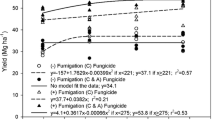Abstract
Nine herbicide treatments were applied to potatoes grown at three locations in each of 3 years. The locations were characterized by widely different soil types—silty clay loam, sandy loam, and muck—and by differences in rainfall and temperatures during the growing season. None of the herbicide treatments applied pre-emergence gave adequate weed control at all locations and/or in all years. EPTC at 6 lb per acre (6.72 kg/ha) gave excellent weed control on both mineral soils but not on muck. Metabromuron at 4 lb per acre (4.48 kg/ha gave excellent weed control only on the low organic matter sandy loam. Propachlor at 6 lb. (6.72 kg/ha) and 2 lb amiben plus 3 lb propachlor (2.24 plus 3.36 kg/ha) gave variable control. Four herbicides: 1 lb paraquat (1.12 kg/ha), 2 lb linuron (2.24 kg/ha), 6 lb dinoseb (6.72 kg/ha) and 6 lb dinoseb plus 2.25 dalapon (6.72 plus 2.52 kg/ha) applied at potato plant emergence, when weeds were in the 2–6 leaf stage, also gave variable control but as a group generally gave better control than the pre-emergence herbicides, particularly on muck soil. The effectiveness of herbicides applied at potato plant emergence was less affected by soil type than those applied pre-emergence but was affected by the degree of weed emergence. On muck soil, weeds generally emerged well before “at emergence” herbicide treatments were applied. Tuber yields were not directly affected by the herbicides, but were reduced where weed control was inadequate. Tuber specific gravity and chip color were unaffected by the herbicides.
Similar content being viewed by others
Literature Cited
Dallyn, Stewart, A. Hawkins, W. M. Iritani, R. Kunkel, and H. Timm. 1967. Current potato herbicide practices in America. Potato Handbook XII: 30–33. Potato Association of America, publ. New Brunswick, New Jersey.
Koren, Ephraim, Chester L. Foy and Floyd M. Ashton. 1969. Adsorption, vola tility, and migration of thiocarbamate herbicides in soil. Weed Science 17: 148–153.
Nelson, Wallace W. and R. E. Nylund. 1959. Control of quackgrass in potatoes. Minn. Farm and Home Science 16 (3): 4.
Nylund, R. E., D. Sanders, E. Quisumbing and W. Shetty. 1968. Pre-emergence weed control in potatoes, 1968. 25th Annual Research Report of the North Central Conf., pp. 30–31.
Nylund, R. E., D. Sanders and E. Quisumbing. 1969. Pre-emergence weed control in potatoes, 1969. 26th annual Research Report of the North Central Weed Control Conf. pp. 35–36.
Stephens, R. P. 1965. The place of herbicides in the potato crop. Eur. Potato J. 8 (#1): 33–51.
Author information
Authors and Affiliations
Additional information
Paper No. 7478 of the Scientific Journal Series of the Minnesota Agricultural Experiment Station.
Formerly Research Assistant, Department of Horticultural Science, University of Minnesota.
Rights and permissions
About this article
Cite this article
Nylund, R.E., Sanders, D.C. & Quisumbing, E. Chemical weed control in potatoes. American Potato Journal 48, 214–221 (1971). https://doi.org/10.1007/BF02862997
Accepted:
Issue Date:
DOI: https://doi.org/10.1007/BF02862997




